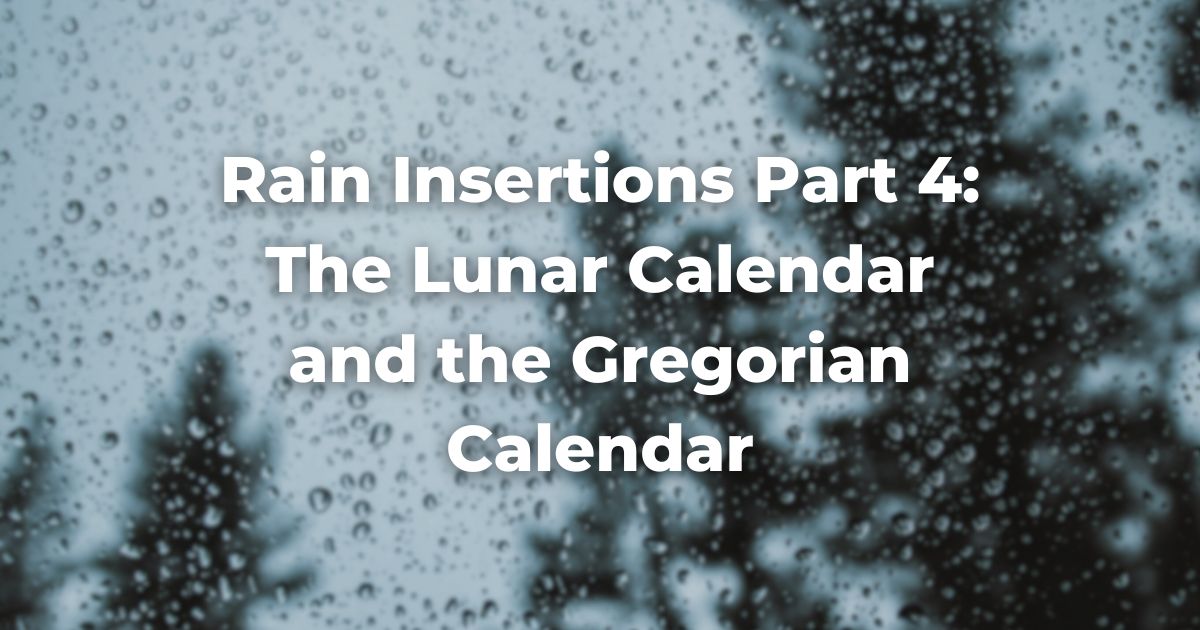The Hebrew calendar is based on the moon. Its months are shorter than secular (Gregorian) months, and change from year to year. Yet one date on the yearly Jewish calendar is tied to the Gregorian calendar: it’s on December 4th/5th that we begin to say Ten Tal uMatar in the Amidah prayer. Why is this transition not tied to a date on the Hebrew calendar?
The Babylonian rule—which we follow today—is to insert Ten Tal uMatar into the Amidah on the sixtieth day of autumn, which is understood to begin on the equinox.
Because the earth is tilted on its axis, as it orbits the sun, there are times where the northern hemisphere is tilted towards the sun and times when it is tilted away. These changes cause the seasons of summer and winter because they change the amount of sunlight we get.
But seasonal changes are not consistent every year. One can’t know the exact number of days until the first snow or when flowers will sprout in the spring. The only way to consistently predict seasonal change is to go back to its cause—astronomy. The astronomical phenomena corresponding to the seasons are the summer and winter solstices and the autumn and spring equinoxes, and they each happen roughly at the quarters of the solar year.
However, the “equinox” cited in the Babylonian rule is not based on a modern astronomical calculation. The calculation we use originates with the Babylonian sage Shmuel, who was discussed in the previous article. His calculation is likely based on that of the Julian calendar, the calendar used by the Romans and Christians until the Gregorian reform of the 16th century.
Historically, the length of the year used for calendars was calculated by measuring the time between two equinoxes. In the Julian calendar, this length was exactly 365 ¼ days, but you can’t have a partial day in a year, so in practice, every four years they would add one day. This might sound familiar today! In the Julian calendar, the autumnal equinox would fall every year on the 24th of September.
The Julian calendar does not specify the time of day when the equinox occurs. This is significant because the time between equinoxes is still exactly 365 ¼ days, so each year the equinox is pushed forward by ¼ of a day, until the leap year where it falls back to its original time. To get the exact time of the equinox, Shmuel picked a time of day for each year. Somewhat arbitrarily, in a leap year, Shmuel’s equinox is at precisely 3am of the 24th. Since ¼ day is 6 hours, it falls at 9am, 3pm and 9pm in subsequent years.
The specific time of day is important because the Jewish day starts at night. This means the Jewish day of the equinox starts on the evening of the 23rd for 3 years. Then in the fall immediately preceding a leap year, when the equinox is after nightfall at 9pm, it starts on the evening of the 24th.
Using this calculation, the 60th day of autumn, when we begin requesting rain, would be on the evening of November 21st, 59 days after the evening of September 23rd—except in years before a Julian leap year, when we would start on the evening of the 22nd of November.
But the 21st/22nd of November is not December 4th/5th, the date on which we insert Ten Tal uMatar. So what happened?
Our calculation has not changed. It is the calendar which has changed around it.
It turns out 365 ¼ days is not quite the length of the solar year; it slips from the solar year by about one day every 128 years. In 1582, Pope Gregory XIII instituted a solution. He corrected the 10-day error that had accumulated since the 4th century by jumping 10 days ahead. This effectively pushed the Julian date 10 days behind the Gregorian date. What was November 21st/22nd in the Julian calendar became December 1st/2nd.
But Pope Gregory also changed the cycle of leap years so that the new Gregorian calendar would stay aligned with the solar year for much longer. He instituted that every year divisible by 100, which would have been a leap year in the Julian calendar, would not be in the new calendar. However, every year divisible by 400, even though it is divisible by 100, is a leap year. Since then, the Julian calendar has continued to slide with respect to the Gregorian.
In each of years 1700, 1800 and 1900 which are leap years in the Julian calendar but not the Gregorian, the date of the insertion slid a day, bringing us to the present date of December 4th/5th. It didn’t slip any further in the year 2000 because 2000 is divisible by 400. It will continue to be on the present date until the year 2100, which is a leap year for the Julian Calendar but not the Gregorian, when it will move to December 5th/6th.
With the exception of the minor practice of Birkat HaChama once every 28 years, the insertion in Birkat HaShanim is the only part of the Jewish calendar which still relies on Shmuel’s calculation of the equinox. The rest of the calendar is adjusted with leap months to correspond more closely with the solar year, but it uses a different date for the equinox and a more accurate year length for its calculation. Shmuel’s calculation remains a largely vestigial remnant of Babylonian calendrical science in our modern Jewish tradition.
However, I believe its persistence is not accidental or unfortunate. On the contrary, what the Jewish people choose to change and what to preserve can teach us deep truths about the significance of our rituals and traditions. We will discuss the reasons for the persistence of this custom in the next article in this series.
Read on: Rain Insertions Part 5: Relating to the Agricultural Setting of the Land of Israel
Author
-

Nadav Elovitz has been involved in Jewish communities and TorahRefers to the first five books of the Hebrew Bible, the Tanakh, also called the Five Books of Moses, Pentateuch or the Hebrew equivalent, Humash. This is also called the Written Torah. The term may also refer to teachings that expound on Jewish tradition. Read more learning throughout his life. He has been a gabbai in the past but has never had any official credentials, though he is interested in a wide variety of topics related to Torah and the Jewish tradition. He is from the Boston area and works as an engineer by day.
View all posts




